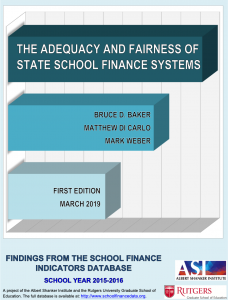NEW REPORT FINDS THAT EDUCATION FUNDING IN MOST STATES FALLS WELL BELOW ADEQUATE LEVELS
The Adequacy and Fairness of State School Finance Systems
First Edition (April 2019)
When it comes to American education, few policy areas are as misunderstood — or as crucial — as school finance.
Over the past several years, a political and empirical consensus has emerged about the importance of equitable and adequate school funding for high quality K-12 education. Certainly, there are plenty of contentious debates about how education funds should be spent. But regardless of one’s opinions on specific education policies, virtually all of the options for improving America’s schools require investment, particularly for disadvantaged students.
We introduce in this report an updated, public database of state school finance measures, and present results for three key measures in this system: effort, adequacy, and progressivity. Our results indicate, as would be expected, that states vary widely on all three measures. There are several states in which educational resources are comparatively adequate and distributed equitably.
In general, however, resources in most states tend to be allocated non-progressively or even regressively, That is, higher poverty districts do not receive more funds — and in some cases receive sustantially less — than do lower poverty districts, even controlling for factors that affect costs, such as regional wage variation, district size, and population density. Moreover, using models that estimate spending levels required to achieve common outcome goals, we find that the vast majority of states spend well under the levels that would be necessary for their higher-poverty districts to achieve national average test scores.
We do not provide state rankings or grades in this report, as the interplay between effort, adequacy and progressivity is complex. We do, however, include recommendations as to how researchers, policymakers, and the public can use our findings, as well as our database, to evaluate state systems and inform debates about improving school finance in the U.S.
Authors: Bruce D. Baker, Matthew Di Carlo, and Mark Weber
Download the full report
Download the press release
Download the full dataset or use data visualizations
The Adequacy and Fairness of State School Finance Systems | School Finance Indicators Database





